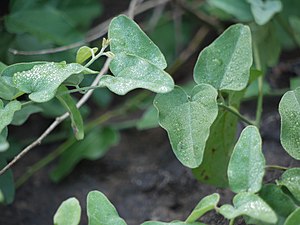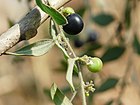Note: This is a project under development. The articles on this wiki are just being initiated and broadly incomplete. You can Help creating new pages.
Difference between revisions of "Cocculus hirsutus - Patalagarudi"
(→References) |
|||
| (9 intermediate revisions by 2 users not shown) | |||
| Line 1: | Line 1: | ||
[[File:Patalagarudi (Sanskrit- पातालगारुडी) (4126773103).jpg|thumb|right|''Patalagarudi'', ''Cocculus hirsutus'']] | [[File:Patalagarudi (Sanskrit- पातालगारुडी) (4126773103).jpg|thumb|right|''Patalagarudi'', ''Cocculus hirsutus'']] | ||
| − | '''Patalagarudi'''is a slender climber with soft hairy leaves. This plant can be found in dry areas during and after the monsoon. | + | '''Patalagarudi''' is a slender climber with soft hairy leaves. This plant can be found in dry areas during and after the monsoon. This plant is belongs to Menispermaceae family.<ref name="Plant family"/> |
| + | ==Uses== | ||
| + | {{Uses|Aphrodisiac}}, {{Uses|Burning sensation}}, {{Uses|Gastritis}}, {{Uses|Skin diseases}}, {{Uses|Poisoning}}.<ref name="Uses"/> | ||
| − | == | + | ===Food=== |
| − | + | Patalagarudi can be used in Food. Leaves are used in curry<ref name="Forest foods of Western Ghat"/>. | |
| − | <ref name=" | ||
==Parts Used== | ==Parts Used== | ||
| Line 10: | Line 11: | ||
==Chemical Composition== | ==Chemical Composition== | ||
| − | The stem contains cyclopeptide alkaloids. The plant contains coclaurine, magnoflorine, beta-sitosterol, ginnol and a monomethyl ether of inositol. <ref name="Chemical composition"/> | + | The stem contains cyclopeptide alkaloids. The plant contains coclaurine, magnoflorine, beta-sitosterol, ginnol and a monomethyl ether of inositol.<ref name="Chemical composition"/> |
==Common names== | ==Common names== | ||
| − | {{Common names|kn= | + | {{Common names|kn=Aadama balli, Adambuballi, Daagadiballi, Kaage maari, Sugadi balli|ml=Pathalagarudakkodi |sa=Garudi, Chilahinta, Vatsadani, Vikranta|ta=Anantavalli, Calakattu, Kattukkodi, Nirppantikkoti, Uppaittiricci|te=Cheepurutheega, Chipurutige, Doosaratheege|hi=Bajar bel, Jamti-ki-bel, Patal garudi|en=}}.<ref name="Common names"/> |
| − | <ref name="Common names"/> | ||
==Properties== | ==Properties== | ||
| Line 32: | Line 32: | ||
===Prabhava=== | ===Prabhava=== | ||
Vishagna (Anti-poison) | Vishagna (Anti-poison) | ||
| + | |||
| + | ===Nutritional components=== | ||
| + | Patalagarudi Contains the Following nutritional components like - Cyclopeptide alkaloids; β-sitosterol, Ginnol, Monomethyl ether of inositol; Calcium, Iron, Magnesium, Phosphorus, Potassium, Sodium<ref name="Forest foods of Western Ghat"/>. | ||
| + | |||
==Habit== | ==Habit== | ||
{{Habit|Climber}} | {{Habit|Climber}} | ||
| Line 37: | Line 41: | ||
==Identification== | ==Identification== | ||
===Leaf=== | ===Leaf=== | ||
| − | {{Leaf|Simple| | + | {{Leaf|Simple|Alternate|1.5-7 x 0.5-4.7 cm, variable in shape, the lower leaves of the main branches larger, sometimes 3-5 lobed.}}<ref name="Leaf"/> |
===Flower=== | ===Flower=== | ||
| − | {{Flower|Unisexual| | + | {{Flower|Unisexual|Axillary|Greenish yellow||Male flowers: sepals greenish, pilose, 3 inner broadly ovate to obovate, 1.5-2.5 mm long.}} |
===Fruit=== | ===Fruit=== | ||
| − | {{Fruit|A drupe|4 - 8mm| | + | {{Fruit|A drupe|4 - 8mm|Turning black, 4-8 mm diam.; endocarp ridged with a prominent do|}} |
===Other features=== | ===Other features=== | ||
| Line 54: | Line 58: | ||
{{Propagation|Seeds}}, {{Propagation|Cuttings}}. | {{Propagation|Seeds}}, {{Propagation|Cuttings}}. | ||
| − | == | + | ==Cultivation Details== |
| − | + | Patalagarudi is available Throughout the year<ref name="Forest foods of Western Ghat"/>. | |
===Season to grow=== | ===Season to grow=== | ||
| Line 73: | Line 77: | ||
File:Ambastha (Sanskrit- अम्बष्ठः) (4429600470).jpg | File:Ambastha (Sanskrit- अम्बष्ठः) (4429600470).jpg | ||
File:Garudi (Sanskrit- गारुडी) (3126470873).jpg | File:Garudi (Sanskrit- गारुडी) (3126470873).jpg | ||
| − | |||
| − | |||
</gallery> | </gallery> | ||
==References== | ==References== | ||
| − | |||
<references> | <references> | ||
| − | <ref name="Uses">https://easyayurveda.com/2015/03/10/patala-garudi-cocculus-hirsutus-uses-dose-research/ | + | <ref name="Uses">[https://easyayurveda.com/2015/03/10/patala-garudi-cocculus-hirsutus-uses-dose-research/ Uses]</ref> |
| − | <ref name="Chemical composition">[http://gbpihedenvis.nic.in/PDFs/Glossary_Medicinal_Plants_Springer.pdf | + | <ref name="Chemical composition">[http://gbpihedenvis.nic.in/PDFs/Glossary_Medicinal_Plants_Springer.pdf Chemical composition]</ref> |
| − | + | <ref name="Leaf">[http://FLOWERING PLANTS OF KERALA VER.2, N. Sasidharan BOTANIC DESCRIPTION]</ref> | |
| − | <ref name="Leaf">[http://FLOWERING PLANTS OF KERALA VER.2, N. Sasidharan | + | <ref name="Common names">[http://envis.frlht.org/bot_search Vernacular names]</ref> |
| − | <ref name="Common names">[http://envis.frlht.org/bot_search | + | <ref name="Plant family">Karnataka Aushadhiya Sasyagalu By Dr.Maagadi R Gurudeva, Page no:181</ref> |
| − | + | <ref name="Forest foods of Western Ghat">"Forest food for Northern region of Western Ghats" by Dr. Mandar N. Datar and Dr. Anuradha S. Upadhye, Page No.58, Published by Maharashtra Association for the Cultivation of Science (MACS) Agharkar Research Institute, Gopal Ganesh Agarkar Road, Pune</ref> | |
| − | |||
</references> | </references> | ||
==External Links== | ==External Links== | ||
| − | * http://tropical.theferns.info/viewtropical.php?id=Cocculus+hirsutus | + | * [http://tropical.theferns.info/viewtropical.php?id=Cocculus+hirsutus Cocculus hirsutus on theferns.info] |
| − | * https://uses.plantnet-project.org/en/Cocculus_hirsutus_(PROTA) | + | * [https://uses.plantnet-project.org/en/Cocculus_hirsutus_(PROTA) Cocculus hirsutus on plantnet-project.org] |
| − | * https://www.sciencedirect.com/science/article/pii/S2314808X1730266X | + | * [https://www.sciencedirect.com/science/article/pii/S2314808X1730266X Cocculus hirsutus on sciencedirect.com] |
[[Category:Herbs]] | [[Category:Herbs]] | ||
Latest revision as of 12:16, 27 October 2021
Patalagarudi is a slender climber with soft hairy leaves. This plant can be found in dry areas during and after the monsoon. This plant is belongs to Menispermaceae family.[1]
Contents
[hide]- 1 Uses
- 2 Parts Used
- 3 Chemical Composition
- 4 Common names
- 5 Properties
- 6 Habit
- 7 Identification
- 8 List of Ayurvedic medicine in which the herb is used
- 9 Where to get the saplings
- 10 Mode of Propagation
- 11 Cultivation Details
- 12 Commonly seen growing in areas
- 13 Photo Gallery
- 14 References
- 15 External Links
Uses
Aphrodisiac, Burning sensation, Gastritis, Skin diseases, Poisoning.[2]
Food
Patalagarudi can be used in Food. Leaves are used in curry[3].
Parts Used
Bark, Leaves, Heartwood, Seeds
Chemical Composition
The stem contains cyclopeptide alkaloids. The plant contains coclaurine, magnoflorine, beta-sitosterol, ginnol and a monomethyl ether of inositol.[4]
Common names
| Language | Common name |
|---|---|
| Kannada | Aadama balli, Adambuballi, Daagadiballi, Kaage maari, Sugadi balli |
| Hindi | Bajar bel, Jamti-ki-bel, Patal garudi |
| Malayalam | Pathalagarudakkodi |
| Tamil | Anantavalli, Calakattu, Kattukkodi, Nirppantikkoti, Uppaittiricci |
| Telugu | Cheepurutheega, Chipurutige, Doosaratheege |
| Marathi | NA |
| Gujarathi | NA |
| Punjabi | NA |
| Kashmiri | NA |
| Sanskrit | Garudi, Chilahinta, Vatsadani, Vikranta |
| English |
.[5]
Properties
Reference: Dravya - Substance, Rasa - Taste, Guna - Qualities, Veerya - Potency, Vipaka - Post-digesion effect, Karma - Pharmacological activity, Prabhava - Therepeutics.
Dravya
Rasa
Tikta (Bitter)
Guna
Laghu (Light), Picchila (Sticky)
Veerya
Ushna (Hot)
Vipaka
Katu (Pungent)
Karma
Vata, Pitta,Kapha
Prabhava
Vishagna (Anti-poison)
Nutritional components
Patalagarudi Contains the Following nutritional components like - Cyclopeptide alkaloids; β-sitosterol, Ginnol, Monomethyl ether of inositol; Calcium, Iron, Magnesium, Phosphorus, Potassium, Sodium[3].
Habit
Identification
Leaf
| Kind | Shape | Feature |
|---|---|---|
| Simple | Alternate | 1.5-7 x 0.5-4.7 cm, variable in shape, the lower leaves of the main branches larger, sometimes 3-5 lobed. |
Flower
| Type | Size | Color and composition | Stamen | More information |
|---|---|---|---|---|
| Unisexual | Axillary | Greenish yellow | Male flowers: sepals greenish, pilose, 3 inner broadly ovate to obovate, 1.5-2.5 mm long. |
Fruit
| Type | Size | Mass | Appearance | Seeds | More information |
|---|---|---|---|---|---|
| A drupe | 4 - 8mm | Turning black, 4-8 mm diam.; endocarp ridged with a prominent do | {{{5}}} | {{{6}}} |
Other features
List of Ayurvedic medicine in which the herb is used
Where to get the saplings
Mode of Propagation
Cultivation Details
Patalagarudi is available Throughout the year[3].
Season to grow
Soil type
Propagation
Commonly seen growing in areas
Photo Gallery
References
- Jump up ↑ Karnataka Aushadhiya Sasyagalu By Dr.Maagadi R Gurudeva, Page no:181
- Jump up ↑ Uses
- ↑ Jump up to: 3.0 3.1 3.2 "Forest food for Northern region of Western Ghats" by Dr. Mandar N. Datar and Dr. Anuradha S. Upadhye, Page No.58, Published by Maharashtra Association for the Cultivation of Science (MACS) Agharkar Research Institute, Gopal Ganesh Agarkar Road, Pune
- Jump up ↑ Chemical composition
- Jump up ↑ Vernacular names
- Jump up ↑ PLANTS OF KERALA VER.2, N. Sasidharan BOTANIC DESCRIPTION
External Links
- Ayurvedic Herbs known to be helpful to treat Aphrodisiac
- Ayurvedic Herbs known to be helpful to treat Burning sensation
- Ayurvedic Herbs known to be helpful to treat Gastritis
- Ayurvedic Herbs known to be helpful to treat Skin diseases
- Ayurvedic Herbs known to be helpful to treat Poisoning
- Herbs with Bark used in medicine
- Herbs with Leaves used in medicine
- Herbs with Heartwood used in medicine
- Herbs with Seeds used in medicine
- Herbs with common name in Kannada
- Herbs with common name in Hindi
- Herbs with common name in Malayalam
- Herbs with common name in Tamil
- Herbs with common name in Telugu
- Herbs with common name in Sanskrit
- Habit - Climber
- Index of Plants which can be propagated by Seeds
- Index of Plants which can be propagated by Cuttings
- Herbs that are commonly seen in the region of Tropical area
- Herbs
- Climber
- Ayurvedic herbs that don't have seed photos
- Menispermaceae




